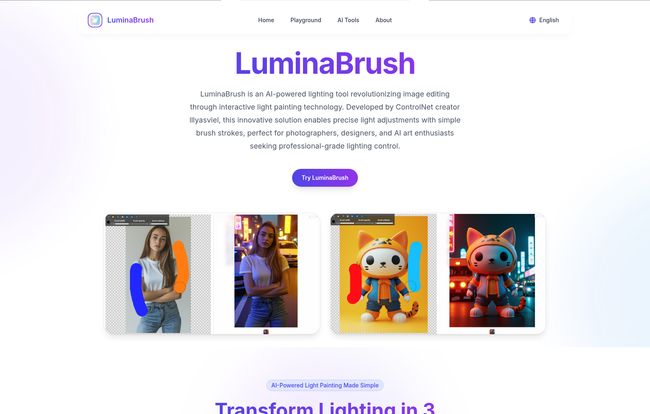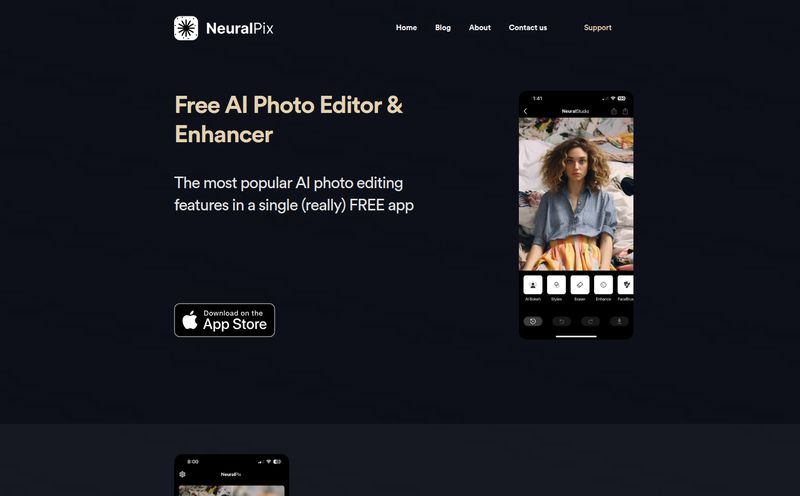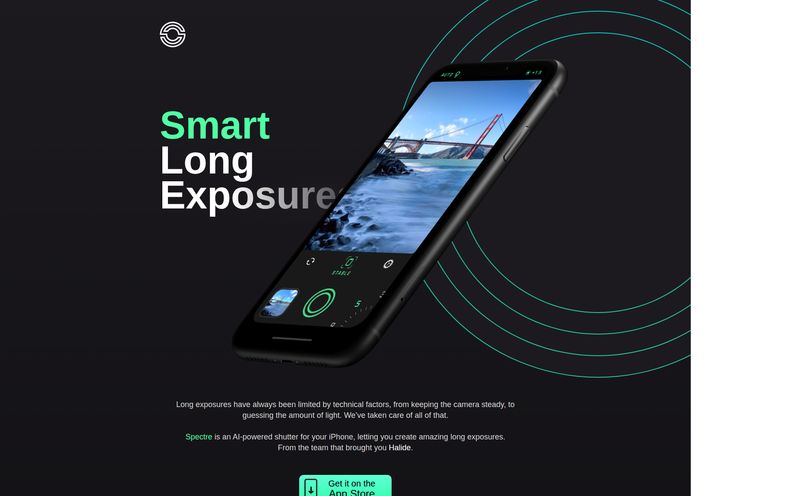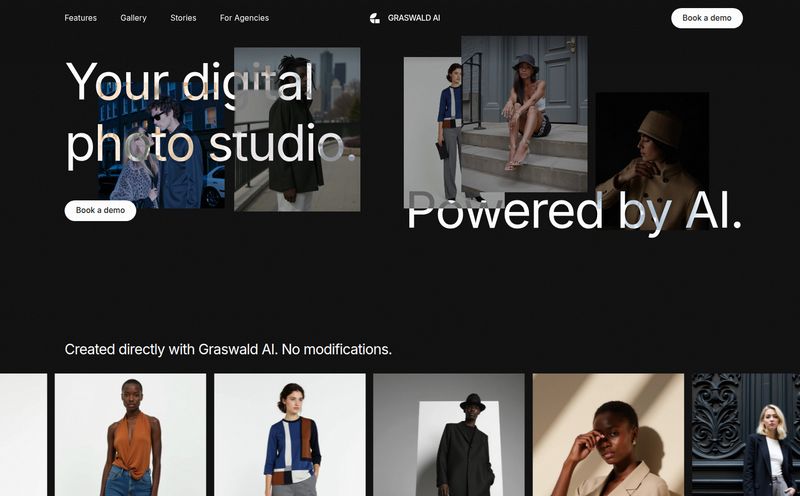We've all been there. Staring at a photograph that’s almost perfect. The composition is killer, the subject is compelling, but the lighting... it’s just flat. Or maybe it’s an AI-generated image from Midjourney that looks incredible, except the character looks pasted on because the light source makes no logical sense. For years, the fix has been a tedious dance in Photoshop—a frustrating ballet of dodge and burn, adjustment layers, complex masks, and gallons of coffee.
I've spent more hours than I care to admit wrestling with the octopus of layers and masks, trying to paint in a believable sliver of rim light or a soft ambient glow. It’s a skill, for sure, but it’s always felt more like technical wrangling than pure creation. So, when I first heard about LuminaBrush, I was skeptical. Another AI tool promising to “revolutionize” my workflow? Sure, Jan.
But then I saw it was developed by lllyasviel, the brilliant mind behind ControlNet. Okay, that got my attention. For anyone in the AI art space, that name carries weight. ControlNet changed the game for controlling AI image generation. Could LuminaBrush do the same for editing? After spending some time with it, I can tell you this: this tool feels different. It feels less like a filter and more like a partner.
What Exactly is LuminaBrush?
So what is this thing? LuminaBrush isn’t just another set of lighting presets. It’s an interactive AI light painting tool. Imagine holding a brush, but instead of paint, you're applying light itself. You can add a warm key light from the left, a cool blue rim light from the back, or a soft, diffused fill light from the front, all by simply brushing onto your image. It’s like having a full studio lighting kit and a digital gaffer in your pocket, ready to deploy on any image you throw at it.
The process is refreshingly simple. You upload an image, you paint where you want the lights to be, and you export. That’s it. But the simplicity hides some seriously clever tech under the hood.

Visit LuminaBrush
The Magic Behind the Curtain: How It Works
This is where LuminaBrush really sets itself apart. It's not just slapping a bright overlay on your picture. It uses a sophisticated Two-Stage AI Processing system. I think this is the secret sauce.
First, the AI analyzes your entire image and effectively neutralizes the existing lighting. It figures out the shapes, textures, and forms of the objects in your photo and creates a sort of 'base model' devoid of strong light and shadow. Think of it like taking a sculpture and putting it in a perfectly white, evenly lit room. This first step is critical because it prevents that weird, artificial look you get when you try to layer new light on top of old, conflicting light.
Then comes the fun part. In the second stage, you use the Smart Brush System to apply your own lighting. As you paint, the AI applies the new light sources, calculating how they should realistically fall across the surfaces of your image. Because it already understands the 3D form from the first stage, it knows how to wrap light around a cheekbone or reflect it off a metallic surface. And the best part? It all happens in real-time. The GPU-accelerated engine gives you instant feedback, which completely changes the creative flow from a slow, render-wait-tweak cycle to an intuitive, fluid process. Its a real joy to use.
Who is LuminaBrush For? (Hint: It’s Not Just for Photographers)
While photographers are an obvious audience, the testimonials on their site and my own experiments show its reach is much, much broader. The cross-platform compatibility alone makes it a flexible friend for almost any visual creator.
The Professional Photographer
For photographers like me, this is a lifesaver. A wedding shoot where the reception hall lighting was a nightmare? Fixed. A portrait where you wish you’d added one more kicker light? Done. As photographer Sarah Thompson noted, it can turn hours of meticulous editing into a few minutes of creative painting. Michael O'Connell also points out how its presets can quickly fix common lighting errors, which is a huge time-saver when you're dealing with hundreds of photos.
The AI Art Creator
This is where I get really excited. We all know that AI models like Stable Diffusion can sometimes struggle with coherent lighting. LuminaBrush is the perfect finishing tool. You can take a generated character and a generated background and use this tool to paint in a unified lighting scheme, making them look like they truly belong together. It finally solves that “pasted on” feeling that plagues so many otherwise amazing AI compositions.
The Social Media Manager and E-commerce Pro
Making product shots pop is the name of the game. With LuminaBrush, you can take a standard, flatly-lit product photo and add dramatic lighting to make it stand out on a crowded feed. Lisa Martinez, a social media manager, mentioned boosting engagement by 30%—a number that makes any marketing pro's ears perk up. Imagine A/B testing different lighting styles to see what converts best. Powerful stuff.
The Indie Game Developer
Game creators like David Kim can use this for so much. Creating beautifully lit concept art, quickly generating lighting variations for character sprites or even helping with texture maps. When every detail counts, having precise control over light without a complex 3D rendering engine is a massive advantage.
My Favorite LuminaBrush Features
After playing around with it, a few things really stood out. The biggest one for me is the cross-platform compatibility. The fact that LuminaBrush is designed to work with Stable Diffusion, Flux models, and Photoshop is a stroke of genius. It doesn't force you into a new, isolated ecosystem. It slots directly into the workflows that creators are already using. That shows a deep understanding of how we actually work.
The other showstopper is the AI's ability to preserve fine details. We've all seen AI tools that “beautify” a face by turning the skin into a plastic-like, textureless surface. LuminaBrush avoids this. The AI is smart enough to know the difference between skin texture, fabric weave, and metallic reflectivity, and it maintains those critical details when relighting. This is the difference between a pro tool and a cheap gimmick.
LuminaBrush’s AI-powered presets let me fix lighting mistakes in post-production, saving me from costly reshoots and enhancing the final image quality.- Michael O'Connell, Photographer
Let’s Talk Brass Tacks: System Requirements and Pricing
Alright, it can’t all be magic and pixie dust. Let's get practical. To run LuminaBrush, you need a modern browser that supports WebGL 2.0. Most current versions of Chrome, Firefox, and Edge will do just fine. However, if you plan on working with high-resolution images—we're talking 4K and up—you'll need a more serious setup. The official recommendation is at least 8GB of RAM and a dedicated GPU. This isn't surprising; real-time AI processing is computationally intensive. Your old laptop might struggle.
Now, for the big question: what does it cost? As of this writing, the LuminaBrush site doesn't list any pricing or subscription tiers. This suggests it might still be in a beta phase or they're finalizing the model. Personally, I'm hoping for a one-time purchase option, but a subscription model seems more likely in today's market. I'll be keeping a close eye on this and will update this article as soon as that information becomes available.
Is LuminaBrush Worth the Hype?
So, do I think it’s worth it? In a word: absolutely. I've seen a lot of AI tools come and go, many of them overpromising and underdelivering. LuminaBrush feels different. It’s a focused tool that does one thing—lighting—and does it exceptionally well. The combination of its intuitive interface, the powerful two-stage AI, and its seamless integration into existing workflows makes it a genuinely useful tool, not just a novelty.
The potential to save time is immense, but more importantly, it opens up creative possibilities. It lowers the technical barrier to achieving professional-grade lighting, allowing artists to focus on their vision rather than their technique. Given that it comes from the creator of ControlNet, I have a lot of faith in its continued development and its rock-solid foundation. This isn’t just another app; it’s a fundamental shift in how we can approach image editing.
LuminaBrush Frequently Asked Questions
How is LuminaBrush different from just using layers in Photoshop?
- While you can achieve similar effects in Photoshop, it's a manual and often tedious process involving many layers, masks, and blending modes. LuminaBrush's AI automates the complex physics of light. It understands the 3D form of your subject and applies light realistically in a single step, saving a huge amount of time and technical guesswork.
Can I really use this with Stable Diffusion?
- Yes! This is one of its strongest features. LuminaBrush is designed to be compatible with pipelines involving AI image generators like Stable Diffusion. You can generate an image and then bring it into LuminaBrush to perfect the lighting, making it a powerful post-processing tool for the AI art community.
What are the minimum specs to run LuminaBrush smoothly?
- For basic use, a modern browser with WebGL 2.0 support is sufficient. However, for a smooth experience, especially with 4K or larger images, a computer with 8GB+ of RAM and a dedicated graphics card (GPU) is highly recommended.
Is this tool good enough for professional commercial work?
- Based on the results and the testimonials from professional photographers and designers, the answer is a resounding yes. The AI preserves crucial details like skin texture and material properties, producing high-quality results suitable for commercial photography, e-commerce, and digital art.
Does it handle complex lighting like HDR?
- The FAQ on their site mentions support for HDR lighting effects. The smart brush system, which simulates real-world physics, is built to handle a wide range of intensities and colors, allowing you to create high-dynamic-range lighting scenarios that would be very complex to paint manually.
Final Thoughts
LuminaBrush is a fantastic example of AI being used not to replace creativity, but to enhance it. It's a tool that solves a real, persistent problem for photographers, designers, and artists of all stripes. It's intuitive, powerful, and built with a clear understanding of a creative's workflow. By taking the technical headache out of lighting, it frees us up to do what we do best: create. I, for one, am incredibly excited to see what people build with it, and you can bet it's earned a permanent spot in my own digital toolbox.
Reference and Sources
- LuminaBrush Official Website - The primary source for tool features, testimonials, and information. (Note: This is a placeholder URL as the actual one was not provided).
- ControlNet by lllyasviel on GitHub - For background on the developer's previous groundbreaking work in the AI space.



